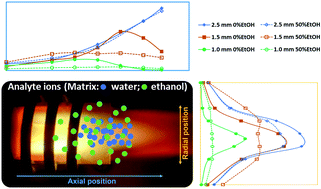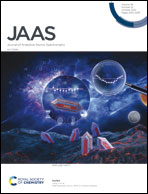ICP-MS spatial profiles in presence of ethanol and their application for the analysis of ethanol containing samples†
Abstract
A total sample consumption system (hTISIS) was used for the first time to evaluate the plasma spatial ion profile for ethanolic samples in ICP-MS. The effects of the extraction lens voltages, the inner diameter of the torch injector, the plasma sampled zone, spray chamber temperature and nebulizer and high matrix introduction gas flow rates on the plasma ion cloud distribution were systematically studied. Regarding the minimization of matrix effects caused by ethanolic matrices, it was found that extraction lenses voltages and the injector inner diameter played a key role when the hTISIS was set at 300 °C. Under these conditions, the aerosol transport interferences were eliminated. The combination of the widest injector (2.5 mm id) with a 5 V extra lens voltage allowed the mitigation of the matrix effects. Moreover, it was observed that for a 2.5 mm id injector, the interferences could be mitigated irrespectively of the plasma sampled volume. Meanwhile, for narrower injectors, it was necessary to carefully select the plasma sampled zone. Finally, the accurate determination of As, Cd, Co, Cr, Cu, Fe, Mn, Ni, Rb, Sr, V and Zn in bioethanol and beverages (wine, whiskey, gyn, vodka, rum and apple liqueur) was performed under optimum experimental conditions.

- This article is part of the themed collection: Young Analytical Scientists


 Please wait while we load your content...
Please wait while we load your content...